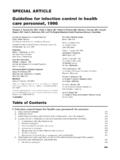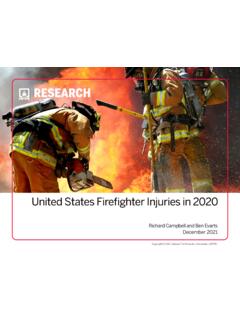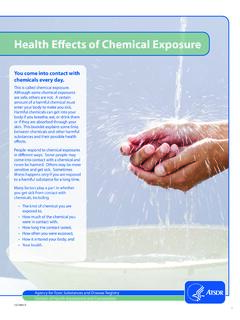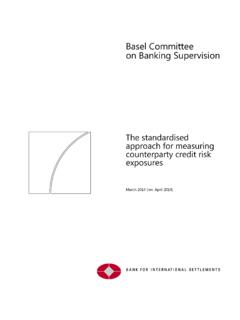Transcription of OSHA’s Respirable Crystalline Silica Standard for Construction
1 OSHA s Respirable Crystalline Silica Standard for ConstructionWorkers who are exposed to Respirable Crystalline Silica dust are at increased risk of developing serious Silica -related diseases. OSHA s Standard requires employers to take steps to protect workers from exposure to Respirable Crystalline is Respirable Crystalline Silica ? Crystalline Silica is a common mineral that is found in Construction materials such as sand, stone, concrete, brick, and mortar. When workers cut, grind, drill, or crush materials that contain Crystalline Silica , very small dust particles are created. These tiny particles (known as Respirable particles) can travel deep into workers lungs and cause silicosis, an incurable and sometimes deadly lung disease. Respirable Crystalline Silica also causes lung cancer, other potentially debilitating respiratory diseases such as chronic obstructive pulmonary disease, and kidney disease.
2 In most cases, these diseases occur after years of exposure to Respirable Crystalline are Construction Workers Exposed to Respirable Crystalline Silica ? exposure to Respirable Crystalline Silica can occur during common Construction tasks, such as using masonry saws, grinders, drills, jackhammers and handheld powered chipping tools; operating vehicle-mounted drilling rigs; milling; operating crushing machines; using heavy equipment for demolition or certain other tasks; and during abrasive blasting and tunneling operations. About two million Construction workers are exposed to Respirable Crystalline Silica in over 600,000 Does the Standard Require?The Standard (29 CFR ) requires employers to limit worker exposures to Respirable Crystalline Silica and to take other steps to protect workers.
3 Employers can either use a control method laid out in Ta b le 1 of the Construction Standard , or they can measure workers exposure to Silica and independently decide which dust controls work best to limit exposures in their workplaces to the permissible exposure limit (PEL).What is Table 1?Table 1 matches 18 common Construction tasks with effective dust control methods, such as using water to keep dust from getting into the air or using a vacuum dust collection system to capture dust. In some operations, respirators may also be needed. Employers who follow Table 1 correctly are not required to measure workers exposure to Silica from those tasks and are not subject to the 1 Example: Handheld Power SawsIf workers are sawing Silica -containing materials, they can use a saw with a built-in system that applies water to the saw blade.
4 The water limits the amount of Respirable Crystalline Silica that gets into the 1: Specified exposure Control Methods When Working With Materials Containing Crystalline SilicaEquipment/Ta s k Engineering and Work Practice Control MethodsRequired Respiratory Protection and Minimum Assigned Protection Factor (APF) 4 hrs/shift> 4 hrs/shiftHandheld power saws (any blade diameter) Use saw equipped with integrated water delivery system that continuously feeds water to the and maintain tool in accordance with manufacturer s instructions to minimize dust emissions. When used outdoors. When used indoors or in an enclosed 10 APF 10 APF 10 Excerpt from Table 1 in 29 CFR this example, if a worker uses the saw outdoors for four hours or less per day, no respirator would be needed.
5 If a worker uses the saw for more than four FactSheethours per day or any time indoors, he or she would need to use a respirator with an assigned protection factor (APF) of at least 10, such as a NIOSH-certified filtering facepiece respirator that covers the nose and mouth (sometimes referred to as a dust mask). See the respiratory protection Standard (29 CFR 1910 .13 4) for information on exposure Control MethodsEmployers who do not fully implement the control methods on Table 1 must: Determine the amount of Silica that workers are exposed to if it is, or may reasonably be expected to be, at or above the action level of 25 g/m3 (micrograms of Silica per cubic meter of air), averaged over an 8-hour day; Protect workers from Respirable Crystalline Silica exposures above the PEL of 50 g/m3, averaged over an 8-hour day; Use dust controls and safer work methods to protect workers from Silica exposures above the PEL; and Provide respirators to workers when dust controls and safer work methods cannot limit exposures to the Else Does the Standard Require?
6 Regardless of which exposure control method is used, all Construction employers covered by the Standard are required to: Establish and implement a written exposure control plan that identifies tasks that involve exposure and methods used to protect workers, including procedures to restrict access to work areas where high exposures may occur; Designate a competent person to implement the written exposure control plan; Restrict housekeeping practices that expose workers to Silica , such as use of compressed air without a ventilation system to capture the dust and dry sweeping, where effective, safe alternatives are available; Offer medical exams including chest X-rays and lung function tests every three years for workers who are required by the Standard to wear a respirator for 30 or more days per year; Train workers on the health effects of Silica exposure , workplace tasks that can expose them to Silica , and ways to limit exposure .
7 And Keep records of workers Silica exposure and medical InformationAdditional information on OSHA s Silica Standard can be found at can provide compliance assistance through a variety of programs, including technical assistance about effective safety and health programs, workplace consultations, and training and s On-Site Consultation Program offers free, confidential occupational safety and health services to small and medium-sized businesses in all states and several territories across the country, with priority given to high-hazard worksites. On-Site consultation services are separate from enforcement and do not result in penalties or citations. Consultants from state agencies or universities work with employers to identify workplace hazards, provide advice on compliance with OSHA standards, and assist in establishing and improving safety and health management systems.
8 To locate the OSHA On-Site Consultation Program nearest you, call 1-800-321-OSHA or visit to Contact OSHAU nder the Occupational Safety and Health Act of 1970, employers are responsible for providing safe and healthful workplaces for their employees. OSHA s role is to ensure these conditions for America s working men and women by setting and enforcing standards, and providing training, education and assistance. For more information, visit or call OSHA at 1-800-321-OSHA (6742), TTY water to the blade of a handheld power saw reduces the amount of dust created when FS-3681 12/2017 This is one in a series of informational fact sheets highlighting OSHA programs, policies or standards. It does not impose any new compliance requirements. For a comprehensive list of compliance requirements of OSHA standards or regulations, refer to Title 29 of the Code of Federal Regulations.
9 This information will be made available to sensory-impaired individuals upon request. The voice phone is (202) 693-1999; teletypewriter (TTY) number: (877) 889-5627.
















